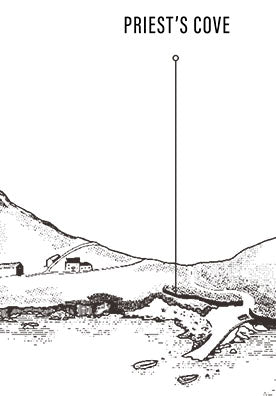Sitting a mile out in the Celtic Sea, The Brisons are a historic Cornwall landmark. These 25m high, twin-peaked islets can be seen clearly from Porth Nanven as well as Priest’s Cove during certain tides. Due to the fact that they look just like a man lying on his back, they’re also fondly known as ‘General de Gaulle in his bath’ to locals, named after the French army officer Charles de Gaulle. With one rock being slightly larger than the other, they’re also called Great and Little Brisons with the word Brisons paying homage to Cornish history as it’s said to come from the Cornish word “Brissen”, which means prison, and that is what these offshore rocks were once used for long ago - a spartan prison.
In Cornish, The Brisons are simply known as Enys Vordardh (breaker island) and they’re connected to Gribba Point by the Guthen Gwidden reef. But what the Brisons are mostly infamous for is being the cause of numerous shipwrecks with many newspapers and diaries reporting the loss of vessels across this harsh and heavily-mined coast. Some even called it a steamboat graveyard with so many boats taking the steering the same course and without GPS, making the same deadly mistakes. Shipwreck experts tell the tale of (at least) two steamers which disappeared during a storm by the Brisons, only to uncover ghostly masts and nothing else a few days later. Very mysterious indeed!


While many of these shipwrecks are now long-forgotten, those which are recorded date back to the early 1900s and include a schooner called the Mary James bound for Swansea that lost her mast and sails and washed up on the Brisons. There was also barque named Luna in 1903 that drifted onto the Brisons in a north-west-by-west gale.
One of most notable and devastating shipwrecks included a
250-ton Whitby-built brig named New Commercial that hit the ledge between the Brisons during thick fog and high wind the winter of 1851. It smashed to pieces and while rescue attempts were made by those watching from the cliffs above Priest’s Cove and by local fishermen who bravely launched their boat through the breakers, only the captain and the cook survived the ordeal. As a result, the National Institution for the Preservation of Life from Shipwreck (now called the
RNLI) established a lifeboat in Sennen Cove in 1853, where one is still based today. A memorial named after the captain’s wife, Mary Sanderson, later rededicated by the Cape Cornwall Coastwatch.
Today The Brisons is owned by
The National Trust. Not only are there a number of good walks in the area, they form a key part of an annual water sports event where swimmers head to the islets and back from Priest’s Cove beach. The Brisons are also an important breeding ground for seabirds and if you’re lucky, you may spot Gannets, Ghags, Gulls, Fulmars or migrants such as Storm-petrels flying around. Thanks to conservation efforts, the Brisons are one of Cornwall’s finest sea bird nesting sites and those who are brave enough to venture out on a boat, may even spot a Puffin or
Red-billed Chough.









